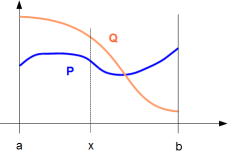(∀x ∈ ]a, b[, Q > 0)
Either P and Q are strictly positive over all ]a, b[.

( ∀x ∈ ]u, b[, Q > 0) and
[P(u) = 0 or Q(u) = 0]
Or P and Q are only strictly positive over an interval ]u, b[.
But in this case, if we take u such that ]u, b[ is the greatest interval such that P and Q are only strictly positive over it, then either P(u) = 0 or Q(u) = 0.
Indeed, if not, either P(u) > 0 and P(u) > 0 but in this case, ]u, b[ is NOT the greatest interval such that P and Q are only strictly positive over it.
Or either P(u) < 0 or Q(u) < 0.
But this is not possible because P and Q are continuous fonction ;

(∀x ∈ ]a, v[, Q > 0) and
[P(v) = 0 or Q(v) = 0]
Or P and Q are only strictly positive over an interval ]a, v[ and P(v) = 0 or P(v) = 0
(∀x ∈ ]u, v[, Q > 0) and
[P(u) = 0 or Q(u) = 0] and
[P(v) = 0 or Q(v) = 0]
Or P and Q are only strictly positive over an interval ]u, v[ and [P(u) = 0 or P(u) = 0] and [P(v) = 0 or P(v) = 0]